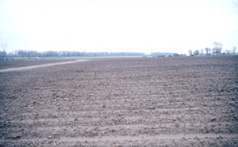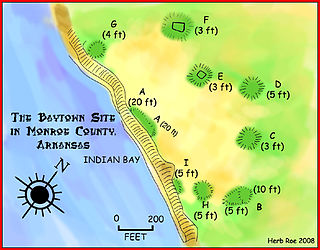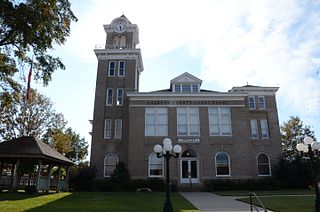
This is a list of properties and districts in Indiana that are listed on the National Register of Historic Places. There are over 1,900 in total. Of these, 39 are National Historic Landmarks. Each of Indiana's 92 counties has at least two listings.
The Cayson Mound and Village Site (8CA3) is a prehistoric archaeological site located near Blountstown, Florida. It is located three miles southeast of Blountstown, on the Apalachicola River. The site was occupied by peoples of the Fort Walton Culture. On March 15, 1976, it was added to the U.S. National Register of Historic Places.

The Nodena site is an archeological site east of Wilson, Arkansas, and northeast of Reverie, Tennessee, in Mississippi County, Arkansas, United States. Around 1400–1650 CE an aboriginal palisaded village existed in the Nodena area on a meander bend of the Mississippi River. The Nodena site was discovered and first documented by Dr. James K. Hampson, archaeologist and owner of the plantation on which the Nodena site is located. Artifacts from this site are on display in the Hampson Museum State Park in Wilson, Arkansas. The Nodena site is the type site for the Nodena phase, believed by many archaeologists to be the province of Pacaha visited by Spanish explorer Hernando de Soto in 1542.

The Eaker site (3MS105) is an archaeological site on Eaker Air Force Base near Blytheville, Arkansas, that was declared a National Historic Landmark in 1996. The site is the largest and most intact Late Mississippian Nodena phase village site within the Central Mississippi Valley, with archaeological evidence indicating a palisaded village some 50 acres (20 ha) in size, with hundreds of structures. The site's major period of occupation was 1350–1450 CE, although evidence of occupation dates back to 600 CE. The site is also hypothesized to have been occupied by the Quapaw prior to a migration further south, after which they made contact with Europeans in the late 17th century.

The Menard–Hodges site (3AR4), is an archaeological site in Arkansas County, Arkansas. It includes two large platform mounds as well as several house mounds. It is the type site for the Menard phase, a protohistoric Mississippian culture group.

This is a list of the National Register of Historic Places listings in Calhoun County, Arkansas.

This is a list of the National Register of Historic Places listings in Boone County, Arkansas.

This is a list of the National Register of Historic Places listings in Hempstead County, Arkansas.

The Baytown Site is a Pre-Columbian Native American archaeological site located on the White River at Indian Bay, in Monroe County, Arkansas. It was first inhabited by peoples of the Baytown culture and later briefly by peoples of the Plum Bayou culture, in a time known as the Late Woodland period. It is considered the type site of the Baytown culture.

Caddo Mounds State Historic Site (41CE19) is an archaeological site in Weeping Mary, Texas. This Caddoan Mississippian culture site is composed of a village and ceremonial center that features two earthwork platform mounds and one burial mound. Located on an ancient Native American trail later named by the Spanish as El Camino Real de los Tejas, the settlement developed hundreds of years before the arrival of Europeans to the region. Archaeologists believe the site was created in approximately 800 CE, with most major construction taking place between 1100 and 1300 CE.

The Hampton Waterworks is a historic site located in Hampton, Arkansas. Completed in 1937, it is the only surviving example of a Public Works Administration-built waterworks in Calhoun County. The site contains a good example of a 1930s-era elevated steel water tower, built by the Pittsburgh-Des Moines Steel Company. The site was added to the National Register of Historic Places in 2006.

The Wright-Patterson Air Force Base Mound, designated 33GR31, is a Native American mound near the city of Dayton in Greene County, Ohio, United States. Named for its location on an Air Force facility, Wright-Patterson Air Force Base, the mound is an archaeological site.

The Coy Site is an archaeological site located next to Indian-Bakers Bayou in Lonoke County, Arkansas. It was inhabited by peoples of the Plum Bayou culture, in a time known as the Late Woodland period. The site was occupied between 700 and 1000 CE. It was listed on the National Register of Historic Places in 1995.
The Roland Site is an archaeological site located on Dry Lake, an extinct channel of the White River in Arkansas County, Arkansas. It was inhabited intermittently from the beginning of the common era to late prehistoric times, but its most intensive inhabitation was by peoples of the Plum Bayou culture, in a time known as the Late Woodland period.

This is a list of the National Register of Historic Places listings in Calhoun County, Illinois.
The Hughes Mound Site, (3SA11), is an archeological site in Saline County, Arkansas near Benton. The 4.5-acre (1.8 ha) is an important Caddoan Mississippian culture village center, at the northeastern frontier of that civilization. It is the only known platform mound site south of Benton on the Saline River. The site has not been dated, but artifacts found there are consistent with the Caddoan period; no contact-period artifacts have been found.
The Crenshaw site (3MI6) is a multiple-mound Caddo ceremonial center located in the Great Bend Region of the Red River in Miller County, Arkansas. It is known for the presence of both "pre-Caddo" or Fourche Maline materials and later Caddo materials. It also has some characteristics that separate it from many other sites including a causeway between two of the mounds, a pile with over 2,000 deer antler, and deposits of human skulls and detached mandibles representing over 300 individuals.

The Calhoun County Courthouse is a courthouse in Hampton, Arkansas, the county seat of Calhoun County, built in 1909. Located within downtown Hampton, the two-story brick building was designed by Frank W. Gibb, who designed 60 courthouses in Arkansas. The courthouse is both a historically and architecturally significant structure, and was listed on the National Register of Historic Places because of this significance in 1976.
The Keller Site is a prehistoric ceremonial center located on a former plantation property in Calhoun County, Arkansas. It consists of a group of burial mounds that were apparently first established by the Coles Creek culture, and the area also saw use in the Caddoan period, c. 1200AD. The site was partially excavated in 1909 by Clarence B. Moore. The site, which was listed on the National Register of Historic Places in 1979, is primarily notable because it is relatively undisturbed, providing the potential for further fruitful research.
The Mounds Cemetery is a historic cemetery in rural Hempstead County, Arkansas. It is located off County Road 13, northwest of the small community of Columbus. It is significant as the site of two Caddoan mounds, and as the burying ground for some of Hempstead County's earliest white settlers. It is further significant as a stopping site along the Trail of Tears, the forced westward relocation of Native Americans in the 19th century.
















